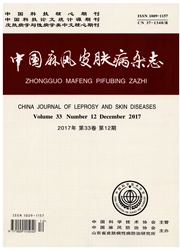

 中文摘要:
中文摘要:
目的:探讨坏疽性脓皮病的临床特点,总结该病的并发症、治疗及预后。方法:回顾性分析1988年至2014年我院19例坏疽性脓皮病住院患者的临床资料并电话随访预后。结果:19例患者中男女比为8∶11。皮损分布特点15例有2处以上皮损,16例有小腿皮损,7例有足部皮损。8例合并相关疾病,2例合并血液系统疾病并死亡,3例肺部侵犯患者中1例死亡1例复发。所有病例使用糖皮质激素及外用药物治疗,其中5例联合免疫抑制剂治疗,3例联合采用大剂量丙种球蛋白治疗,部分患者联合了其他治疗方法。19例患者随访成功11例,2例死亡,2例复发自行去他院治疗,痊愈7例。结论:坏疽性脓皮病经常合并系统性疾病,尤其需要注意血液和肺部等系统检查,治疗以皮质类固醇激素为主,早期可采用大剂量丙种球蛋白控制,后期需要激素联合免疫抑制剂长期维持。
 英文摘要:
英文摘要:
Objective: To analyze clinical features of pyoderma gangrenosum( PG), and summarize complications,treatment and prognosis of PG. Methods: The clinical data of 19 patients with pyoderma gangrenosum from 1988 to 2014 were analyzed retrospectively. The results of prognosis were collected by telophone call. Results: That the male / female ratio in the 19 patients was 8 /11. Total 15 patients had more than 2 lesions.There were 16 cases with lesions in shanks,7 cases with lesions in feet. There were 8 cases with complications or related systemic diseases. The results of prognosis showed that 2 patients complicated with blood diseases died.Total 3 patients showed the lung involvment of PG,and one patient died and one suffured from relapse. All patients were treated with glucocorticoids and topical medicines,and 5 patients were also treated with immunosuppressors.The large dose intravenous immunoglobulin( IVIG) was also used to treat 3 patinets. The prognosis data of 11 patients were collected successfully. 2 cases died,and 2 cases suffered from relapse,and 7 cases were cured.Conclusion: PG often appear in complicating with systemic diseases,and it is important to pay more attenttion to blood system and lung. Glucocorticoid is the first-line drug to treat PG. IVIG shows a good therapeutic effect to control PG in ealy stage,but it is necessary to use glucocorticoids combined with immunosuppressors to prevent PG relapse for a long time.
 同期刊论文项目
同期刊论文项目
 同项目期刊论文
同项目期刊论文
 期刊信息
期刊信息
